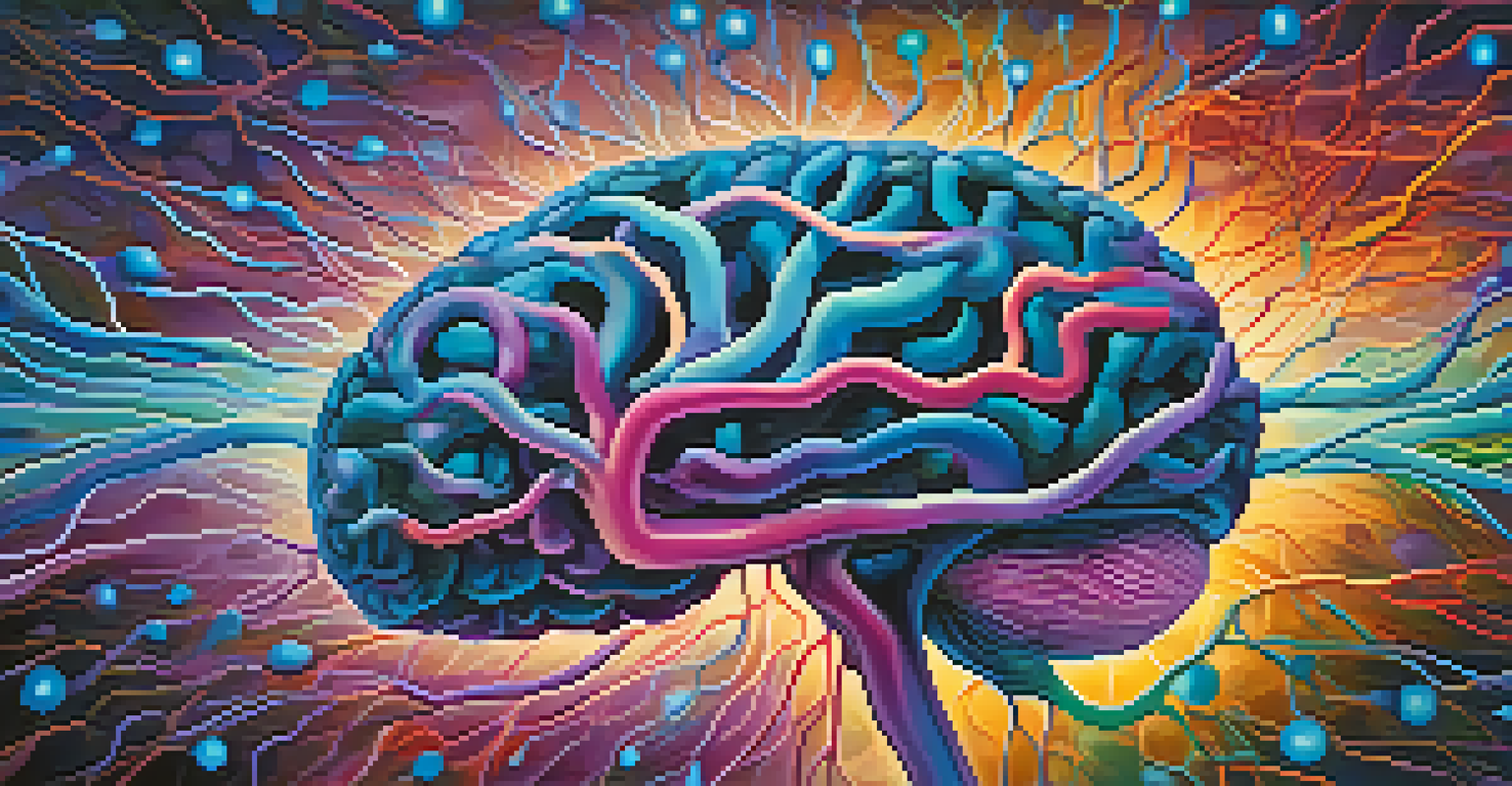Ayahuasca and Neuroplasticity: Implications for Psychological Healing

Understanding Ayahuasca: A Brief Overview
Ayahuasca is a traditional Amazonian brew made from the Banisteriopsis caapi vine and other plants, often used in spiritual ceremonies. Its psychoactive properties are largely attributed to DMT (dimethyltryptamine), a compound that can evoke profound psychological experiences. Many who partake in Ayahuasca ceremonies describe transformative insights and emotional healing, sparking interest in its therapeutic potential.
The mind is like water. When it's turbulent, it's difficult to see. When it's calm, everything becomes clear.
The brew has been used for centuries by indigenous cultures for healing and spiritual purposes. Participants often report a deep connection to nature, themselves, and a greater understanding of their life's purpose. This rich cultural backdrop sets the stage for exploring Ayahuasca’s effects on the brain and its potential role in psychological healing.
In recent years, Ayahuasca has gained attention in the Western world, with retreats and ceremonies becoming increasingly popular. As more people seek alternative mental health treatments, understanding the science behind Ayahuasca's effects, particularly on neuroplasticity, becomes crucial in assessing its therapeutic benefits.
What is Neuroplasticity and Why It Matters
Neuroplasticity refers to the brain's ability to reorganize itself by forming new neural connections throughout life. This remarkable capability allows the brain to adapt to new experiences, learn new information, and even recover from injury. Understanding neuroplasticity is essential as it underpins the brain's resilience and potential for healing.

For individuals struggling with mental health issues, neuroplasticity offers hope. It means that even entrenched patterns of thought and behavior can change, paving the way for recovery and personal growth. This adaptability is particularly significant in the context of trauma, addiction, and depression, where traditional methods may fall short.
Ayahuasca and Emotional Healing
Ayahuasca has been shown to evoke transformative insights and emotional healing, making it a focal point in discussions about alternative mental health treatments.
Harnessing neuroplasticity through various techniques—like therapy, mindfulness, and, as we will explore, Ayahuasca—can facilitate profound changes in how we think and feel. Embracing neuroplasticity can empower individuals to reshape their mental landscapes, making it a vital component of psychological healing.
Ayahuasca's Influence on Neuroplasticity
Research suggests that Ayahuasca may stimulate neuroplasticity, promoting the growth of new brain cells and connections. This effect can be particularly beneficial for individuals undergoing psychological healing, as it opens the door to new ways of thinking and feeling. The altered state of consciousness induced by Ayahuasca may allow for deeper introspection and emotional release, facilitating healing at a core level.
In the midst of movement and chaos, keep stillness inside of you.
One study indicated that participants who experienced Ayahuasca reported changes in their emotional regulation and cognitive flexibility—both indicators of neuroplasticity. These changes can lead to healthier coping mechanisms and a shift in perspective, allowing individuals to break free from negative thought patterns. Essentially, Ayahuasca may act as a catalyst for change, enabling the brain to rewire itself in beneficial ways.
The connection between Ayahuasca and neuroplasticity highlights the potential for this traditional brew to aid in therapeutic practices. As we continue to explore its effects, it becomes increasingly clear that Ayahuasca could play a significant role in modern psychological healing.
The Role of Serotonin and Brain Chemistry
When consumed, Ayahuasca affects serotonin receptors in the brain, particularly the 5-HT2A receptor, which is linked to mood regulation and cognition. This interaction can lead to enhanced emotional processing and a greater sense of well-being. Understanding how Ayahuasca influences brain chemistry helps explain its emotional and psychological effects.
The elevation of serotonin levels during an Ayahuasca experience may also contribute to neuroplasticity by promoting the growth of new neurons. This biochemical response could be one reason why many individuals report long-lasting positive changes in their mental health after participating in ceremonies. It’s fascinating to consider how a single experience could result in such profound shifts.
The Science of Neuroplasticity
Neuroplasticity, the brain's ability to reorganize itself, is crucial for personal growth and recovery, especially for those dealing with mental health challenges.
Moreover, the combination of psychoactive compounds in Ayahuasca creates a unique environment for introspection and emotional healing. This interplay of chemistry and consciousness is central to understanding how Ayahuasca can facilitate neuroplasticity and support therapeutic outcomes.
Real-Life Experiences: Testimonies of Transformation
Many individuals who have participated in Ayahuasca ceremonies share stories of personal transformation and healing. These narratives often highlight a newfound sense of clarity, emotional release, and the ability to confront past traumas. Such testimonials provide anecdotal evidence of Ayahuasca’s potential to foster neuroplasticity and facilitate psychological healing.
For example, some participants report significant reductions in anxiety and depression after their experiences, attributing their healing to the insights gained during the ceremony. These transformations often lead to lasting changes in mindset and behavior, showcasing the possible long-term effects of Ayahuasca on mental health.
These real-life stories underscore the importance of further research into Ayahuasca and its therapeutic applications. As more people seek alternative pathways to healing, understanding the intersection of personal narratives and scientific inquiry will enhance our knowledge of this powerful brew.
Potential Risks and Considerations
While Ayahuasca offers promising therapeutic benefits, it's essential to recognize potential risks associated with its use. The intensity of the experience can be overwhelming for some, leading to psychological distress or challenging emotional confrontations. Participants should approach Ayahuasca with respect and awareness of their mental health history.
Additionally, Ayahuasca can interact with certain medications, particularly those affecting serotonin levels, leading to potentially dangerous side effects. It's crucial for individuals to consult with healthcare professionals before participating in ceremonies, ensuring that they are in a safe environment and adequately prepared for the experience.
Risks of Ayahuasca Use
While promising for therapeutic benefits, Ayahuasca carries potential risks, emphasizing the need for responsible use and medical consultation.
Understanding the risks does not diminish the potential of Ayahuasca for healing; instead, it emphasizes the need for responsible use and informed decision-making. By being aware of these considerations, individuals can better navigate their journeys toward psychological healing.
The Future of Ayahuasca in Psychological Healing
As interest in Ayahuasca grows, researchers are beginning to explore its therapeutic potential within clinical settings. Studies are underway to investigate its effects on conditions like PTSD, depression, and addiction, aiming to provide scientific validation for its traditional uses. This research could pave the way for integrating Ayahuasca into mainstream mental health treatments.
The future of Ayahuasca in psychological healing holds promise, particularly as more individuals seek holistic and alternative approaches to mental health. By combining ancient wisdom with modern science, we can uncover new pathways for healing and transformation.

Ultimately, the exploration of Ayahuasca and its impact on neuroplasticity is just beginning. As we continue to learn and understand this powerful plant medicine, it may unlock new opportunities for psychological healing and personal growth for many.